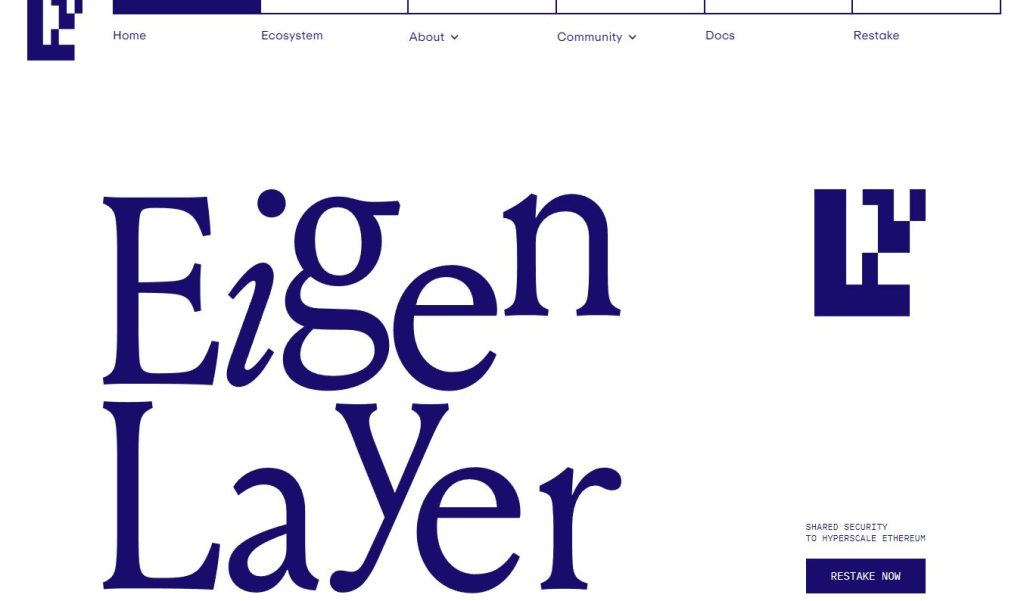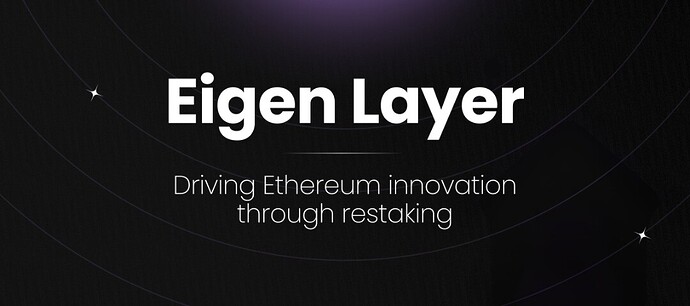If you ever wonder “what is EigenLayer”, you are at the right place to understand it by our article. This is a second layer protocol built on the Ethereum network, which introduces restaking. That means it allow the users to restake their ETH without unstaking the original staked asset. Here you can understand how it works, its origins and the risks and benefits of EigenLayer.
What Is EigenLayer Protocol? – Ethereum Restaking Protocol
EigenLayer is an innovative layer that built on the Ethereum blockchain. This protocol introduces the restaking concept. It’s a bit like getting a second use out of a single resource, increasing efficiency and output.
Restaking by Eigen allows ETH stakers to use their assets more dynamically. Users who have already staked their Ethereum or Liquid Staking Tokens (LSTs) can opt to restake them. This process adds to the security of an emerging set of decentralized services on the Ethereum blockchain, much like a single key unlocking multiple doors of opportunity. As a reward for their increased participation, Stakers are given the opportunity to earn additional rewards. There are already have over 175,000 ETH in Total Value Locked (TVL).
EigenLayer offers the opportunity to change the way how decentralized trust is constructed and used in the Ethereum ecosystem. Protocols integrating EigenLayer can benefit from Ethereum’s security network without facing the significant cost and complexity of building their own validator sets. This opens up possibilities for innovation in the crypto space, let new protocols to develop with lower barriers to entry.
Origin of EigenLayer
The story of EigenLayer begins with its creation by EigenLabs, a forward-thinking team based in Seattle, Washington. Sreeram Kannan is the lead behind this protocol, a figure known for his expertise in both academia and blockchain technology. Kannan, a former professor at the University of Washington and head of its Blockchain Lab, founded EigenLayer as a solution to some of the most pressing challenges in the Ethereum ecosystem.

EigenLayer started at the University of Washington’s Blockchain Lab, where a team of skilled devs, including engineers and cryptography experts, first collaborated. This team, comprising talents like Robert Raynor, Soubhik Deb, Bowen Xue, and product expert Vyas Krishnan, brought together a unique blend of mathematical skills and cryptographic knowledge. They wanted to create a protocol that improves Ethereum’s functionality abd opens up a world of possibilities for developers and market participants.
EigenLayer’s journey from concept to a reality was fueled by massive funding and investor confidence. This is evidenced by its recent Series A funding round, which raised a remarkable $50 million, led by Blockchain Capital. This financial backing, following an earlier seed round of $14.5 million, reflects the market’s strong belief in EigenLayer’s potential to redefine Ethereum’s decentralized services and security.
How Does EigenLayer Work?
To understand how EigenLayer works, let’s see its mechanics. The first step in EigenLayer’s process is the act of staking ETH or Liquid Staking Tokens (like stETH, rETH, or cbETH) on the Ethereum network. This is where the similarity with traditional staking ends and the unique approach of EigenLayer begins.
Once the assets are staked, users interact with EigenLayer’s smart contracts to activate the restaking function. By opting in these specific contracts, users can use their staked assets to secure additional decentralized services on the Ethereum network. It’s like redeploying energy from a central power plant to support new, growing neighborhoods.
This process optimizes the staked capital base, as stakers secure the Ethereum blockchain and contribute to the security of multiple other decentralized services in its ecosystem. This effect increases the overall cryptoeconomic security of the network.
A key feature of EigenLayer is its flexibility. The protocol allows for simultaneous opt-ins to multiple security pools, reducing the capital entry barrier and improving the trust level across the system. This is similar to a single investment spreading its influence across several projects.
Moreover, EigenLayer is designed to grow. Future updates are expected to allow stakers to delegate their restaked assets to specific operators. This provides a more focused and strategic way of staking, allowing users to adapt their participation according to their preferences or risk tolerance.
Safety is also a priority. EigenLayer requires a withdrawal hold period, adding a security layer to the process. This is similar to a cooling-off period in financial transactions, making sure decisions are made without unnecessary rush.
EigenDA: An Alternative Data Availability Layer
EigenDA is a specialized Data Availability Layer for the Ethereum network. This component reduces the high gas fees often associated with Ethereum’s Layer 2 solutions. Unlike traditional Layer 1 setups where data availability is built-in, EigenDA operates as a distinct, separate protocol, but still benefits from Ethereum’s security.
EigenDA’s role is to reduce network traffic by handling part of the data processing, which loads the Layer 1 network. This separation leads to more efficient processing and lower transaction costs.
The power of EigenDA lies in its ability to handle data at a much higher rate than Ethereum’s base layer. This boost in data processing capacity is not just a technical improvement, it opens up new ways for applications needing high data throughput.
EigenDA also plays a role in addressing Ethereum’s maximal extractable value (MEV) censorship issues. As part of EigenLayer, it includes mechanisms to penalize misbehaving block proposers, thereby tackling the problem of censorship in the network.
Benefits of EigenLayer
EigenLayer, as a middleware built on top of Ethereum blockchain, brings several benefits to the Ethereum ecosystem. Firstly, it extends the role of Ethereum validators by allowing them to provide pooled security. This means that validators can extend their security services beyond the base layer of Ethereum to other protocols, effectively maximizing the utility of their staked ETH.

Secondly, EigenLayer allows additional yield opportunities for stakers. By restaking their assets, users can earn rewards not only from the Ethereum network but also from other protocols they help secure. This creates a more efficient and profitable environment for stakers.
Another key benefit is the increased security and robustness it brings to the Ethereum network. As a middleware, EigenLayer strengthens the network’s consensus layer. This added layer of security reduces risks and increases the trust in the Ethereum ecosystem.
Furthermore, EigenLayer catalyzes innovation and development. By providing a platform for new protocols to easily access Ethereum’s pooled security, it lowers the barrier to entry for developers, resulting in more innovation and diversity in the applications built on Ethereum.
Risks of EigenLayer
While EigenLayer presents some benefits, it’s important to acknowledge the associated risks. One of the primary concerns is the increased slashing risk. When stakers opt to restake their ETH through EigenLayer, they expose themselves to additional slashing conditions. This means that if a security breach or a violation of the protocol’s rules happens, they could face a higher probability of losing a portion or all of their staked ETH.
Another risk is systemic risk. By enabling restaking, EigenLayer introduces a new level of complexity and dependency in the network. If something goes wrong with the protocol or application that integrated in EigenLayer, it could trigger a domino effect, impacting the stability and security of other interconnected protocols, including the Ethereum base layer.
Furthermore, the concept of a data availability layer, brings its own set of challenges. Managing and making sure the integrity of this additional layer adds another layer of complexity to the Ethereum ecosystem, which could be a point of vulnerability if it managed badly.




